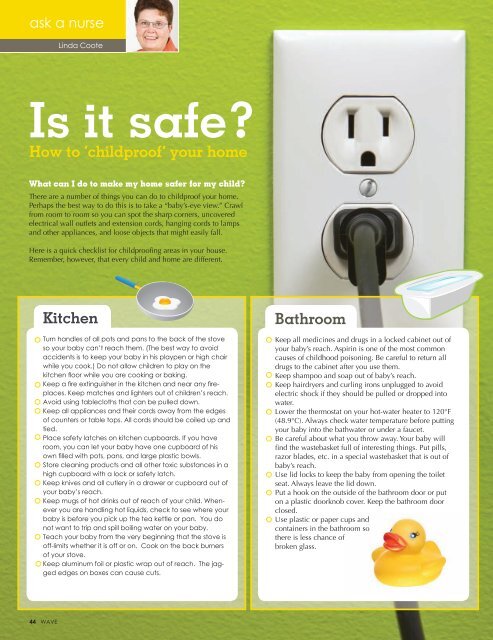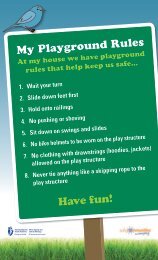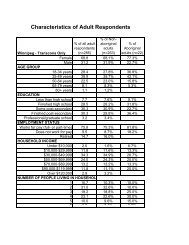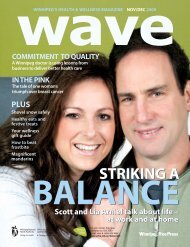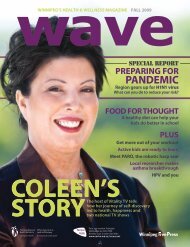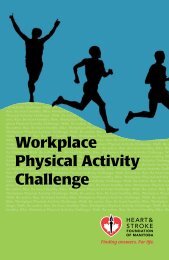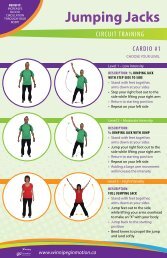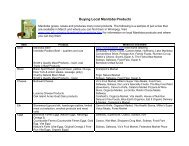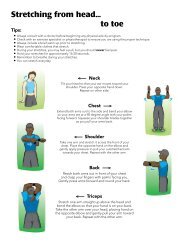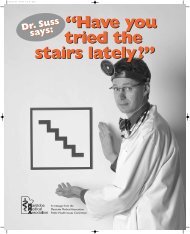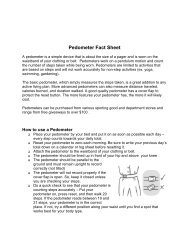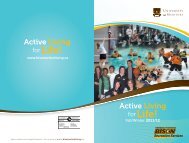Wave: March / April 2010 - Winnipeg in motion
Wave: March / April 2010 - Winnipeg in motion
Wave: March / April 2010 - Winnipeg in motion
You also want an ePaper? Increase the reach of your titles
YUMPU automatically turns print PDFs into web optimized ePapers that Google loves.
ask a nurse<br />
L<strong>in</strong>da Coote<br />
Is it safe?<br />
How to ‘childproof’ your home<br />
What can I do to make my home safer for my child?<br />
There are a number of th<strong>in</strong>gs you can do to childproof your home.<br />
Perhaps the best way to do this is to take a “baby’s-eye view.” Crawl<br />
from room to room so you can spot the sharp corners, uncovered<br />
electrical wall outlets and extension cords, hang<strong>in</strong>g cords to lamps<br />
and other appliances, and loose objects that might easily fall.<br />
Here is a quick checklist for childproof<strong>in</strong>g areas <strong>in</strong> your house.<br />
Remember, however, that every child and home are different.<br />
Kitchen<br />
Turn handles of all pots and pans to the back of the stove<br />
so your baby can’t reach them. (The best way to avoid<br />
accidents is to keep your baby <strong>in</strong> his playpen or high chair<br />
while you cook.) Do not allow children to play on the<br />
kitchen floor while you are cook<strong>in</strong>g or bak<strong>in</strong>g.<br />
Keep a fire ext<strong>in</strong>guisher <strong>in</strong> the kitchen and near any fireplaces.<br />
Keep matches and lighters out of children’s reach.<br />
Avoid us<strong>in</strong>g tablecloths that can be pulled down.<br />
Keep all appliances and their cords away from the edges<br />
of counters or table tops. All cords should be coiled up and<br />
tied.<br />
Place safety latches on kitchen cupboards. If you have<br />
room, you can let your baby have one cupboard of his<br />
own filled with pots, pans, and large plastic bowls.<br />
Store clean<strong>in</strong>g products and all other toxic substances <strong>in</strong> a<br />
high cupboard with a lock or safety latch.<br />
Keep knives and all cutlery <strong>in</strong> a drawer or cupboard out of<br />
your baby’s reach.<br />
Keep mugs of hot dr<strong>in</strong>ks out of reach of your child. Whenever<br />
you are handl<strong>in</strong>g hot liquids, check to see where your<br />
baby is before you pick up the tea kettle or pan. You do<br />
not want to trip and spill boil<strong>in</strong>g water on your baby.<br />
Teach your baby from the very beg<strong>in</strong>n<strong>in</strong>g that the stove is<br />
off-limits whether it is off or on. Cook on the back burners<br />
of your stove.<br />
Keep alum<strong>in</strong>um foil or plastic wrap out of reach. The jagged<br />
edges on boxes can cause cuts.<br />
Bathroom<br />
Keep all medic<strong>in</strong>es and drugs <strong>in</strong> a locked cab<strong>in</strong>et out of<br />
your baby’s reach. Aspir<strong>in</strong> is one of the most common<br />
causes of childhood poison<strong>in</strong>g. Be careful to return all<br />
drugs to the cab<strong>in</strong>et after you use them.<br />
Keep shampoo and soap out of baby’s reach.<br />
Keep hairdryers and curl<strong>in</strong>g irons unplugged to avoid<br />
electric shock if they should be pulled or dropped <strong>in</strong>to<br />
water.<br />
Lower the thermostat on your hot-water heater to 120°F<br />
(48.9°C). Always check water temperature before putt<strong>in</strong>g<br />
your baby <strong>in</strong>to the bathwater or under a faucet.<br />
Be careful about what you throw away. Your baby will<br />
f<strong>in</strong>d the wastebasket full of <strong>in</strong>terest<strong>in</strong>g th<strong>in</strong>gs. Put pills,<br />
razor blades, etc. <strong>in</strong> a special wastebasket that is out of<br />
baby’s reach.<br />
Use lid locks to keep the baby from open<strong>in</strong>g the toilet<br />
seat. Always leave the lid down.<br />
Put a hook on the outside of the bathroom door or put<br />
on a plastic doorknob cover. Keep the bathroom door<br />
closed.<br />
Use plastic or paper cups and<br />
conta<strong>in</strong>ers <strong>in</strong> the bathroom so<br />
there is less chance of<br />
broken glass.<br />
44 WAVE


